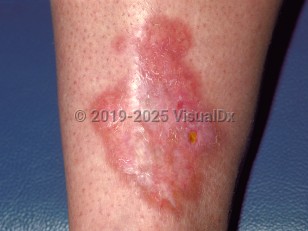Necrobiosis lipoidica
See also in: Cellulitis DDxAlerts and Notices
Important News & Links
Synopsis

Necrobiosis lipoidica (NL) is a rare, chronic granulomatous disease characterized by indolent atrophic plaques typically located on the lower extremities.
While the majority of NL cases are found in patients with diabetes (studies range from 11%-65% of cases), the incidence of NL in diabetic patients is low, only 0.3%-1.2%. NL is also associated with sarcoidosis, inflammatory bowel disease (Crohn disease, ulcerative colitis), autoimmune thyroiditis, monoclonal gammopathies, and it has even been described in otherwise healthy patients. Importantly, NL may be the first sign of diabetes in a patient with no previous diagnosis. NL typically presents in the third decade of life and later in patients without diabetes. There are documented cases of pediatric onset as well. It is 3 times more common in women than in men and has no known racial predilection.
The exact etiology of NL remains unclear, but microangiopathy due to glycoprotein deposition, immunoglobulin deposition, and abnormal collagen production have all been linked.
NL typically presents unilaterally or bilaterally on the pretibial surface of the lower extremities as well-demarcated yellow, red, or brown atrophic plaques with prominent telangiectasias and an elevated violaceous rim. Atypical cases of NL have been reported on the face, trunk, upper extremities, and penis. The lesions predictably enlarge slowly over the course of months to years without intervention. The lesions may begin as asymptomatic papules, but as they progress, patients often report pruritus, dysesthesia, or pain. NL may koebnerize, ulcerate, or be exacerbated by trauma.
Malignant transformation has rarely been reported, most commonly to cutaneous squamous cell carcinoma, but basal cell carcinoma and malignant melanoma have also been reported within NL.
While the majority of NL cases are found in patients with diabetes (studies range from 11%-65% of cases), the incidence of NL in diabetic patients is low, only 0.3%-1.2%. NL is also associated with sarcoidosis, inflammatory bowel disease (Crohn disease, ulcerative colitis), autoimmune thyroiditis, monoclonal gammopathies, and it has even been described in otherwise healthy patients. Importantly, NL may be the first sign of diabetes in a patient with no previous diagnosis. NL typically presents in the third decade of life and later in patients without diabetes. There are documented cases of pediatric onset as well. It is 3 times more common in women than in men and has no known racial predilection.
The exact etiology of NL remains unclear, but microangiopathy due to glycoprotein deposition, immunoglobulin deposition, and abnormal collagen production have all been linked.
NL typically presents unilaterally or bilaterally on the pretibial surface of the lower extremities as well-demarcated yellow, red, or brown atrophic plaques with prominent telangiectasias and an elevated violaceous rim. Atypical cases of NL have been reported on the face, trunk, upper extremities, and penis. The lesions predictably enlarge slowly over the course of months to years without intervention. The lesions may begin as asymptomatic papules, but as they progress, patients often report pruritus, dysesthesia, or pain. NL may koebnerize, ulcerate, or be exacerbated by trauma.
Malignant transformation has rarely been reported, most commonly to cutaneous squamous cell carcinoma, but basal cell carcinoma and malignant melanoma have also been reported within NL.
Codes
ICD10CM:
E13.620 – Other specified diabetes mellitus with diabetic dermatitis
SNOMEDCT:
9418005 – Necrobiosis lipoidica
E13.620 – Other specified diabetes mellitus with diabetic dermatitis
SNOMEDCT:
9418005 – Necrobiosis lipoidica
Look For
Subscription Required
Diagnostic Pearls
Subscription Required
Differential Diagnosis & Pitfalls

To perform a comparison, select diagnoses from the classic differential
Subscription Required
Best Tests
Subscription Required
Management Pearls
Subscription Required
Therapy
Subscription Required
References
Subscription Required
Last Reviewed:06/14/2022
Last Updated:01/09/2025
Last Updated:01/09/2025
Necrobiosis lipoidica
See also in: Cellulitis DDx
